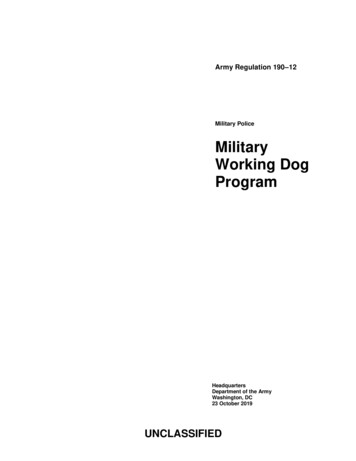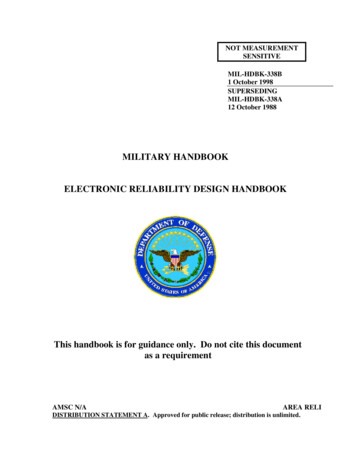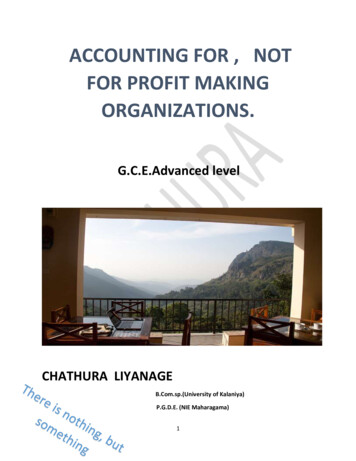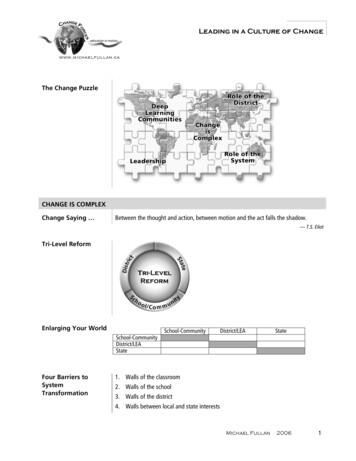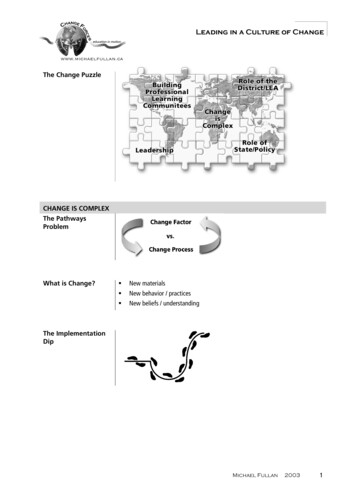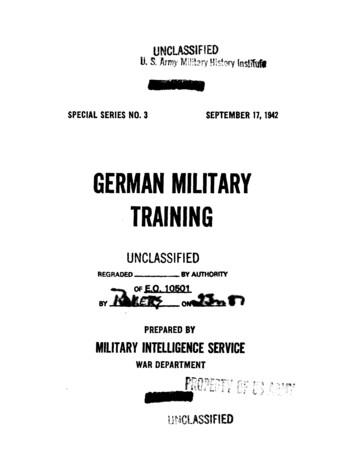
Transcription
Leading changein military organizations?First editionUnited States army war college
Leading Changein Military OrganizationsPrimer for Senior Leaders1st EditionTom GalvinForeword By Charles D. AllenDepartment of Command, Leadership, andManagementSchool of Strategic LandpowerU.S. Army War College, Carlisle PA
II Leading Change in Military OrganizationsComments pertaining to this report are invited and should beforwarded to the author, Dr. Thomas P. Galvin, Department ofCommand, Leadership, and Management, School of StrategicLandpower, U.S. Army War College, 122 Forbes Avenue, Carlisle,PA 17013-5010.*****All U.S. Army War College (USAWC) Press publications maybe downloaded free of charge from the USAWC Publicationswebsite. Hard copies of certain reports may also be obtained freeof charge while supplies last by placing an order on the StrategicStudies Institute (SSI) website. Check the website for availability.Strategic Studies Institute publications may be quoted orreprinted in part or in full with permission and appropriate creditgiven to the U.S. Army Strategic Studies Institute and U.S. ArmyWar College Press, U.S. Army War College, Carlisle, PA. ContactSSI by visiting our website at the following *The Strategic Studies Institute and U.S. Army War CollegePress publishes a monthly email newsletter to update the nationalsecurity community on the research of our analysts, recent andforthcoming publications, and upcoming conferences sponsoredby the Institute. Each newsletter also provides a strategiccommentary by one of our research analysts. If you are interestedin receiving this newsletter, please subscribe on the SSI website athttp://ssi.armywarcollege.edu/newsletter/Cover design by Jennifer Nevil, Tom Galvin, and ArinBurgess. Original graphic elements from DoD and U.S. http://vectorbg.net.ISBN: 1-58487-781-2
U.S. Army War College IIITable of ContentsTable of Contents . IIIList of Figures . IVAcknowledgements . VForeword . VIIChapter 1. The Challenges of “Leading Change” in MilitaryOrganizations . 1Chapter 2. Senior Leaders as Change Agents . 11Chapter 3. Ideas about Social Change . 19Chapter 4. Defining the Change Problem . 31Chapter 5. Diagnosing the Current State . 47Chapter 6. Envisioning the Change – Vision and ConceptDevelopment . 61Chapter 7. Planning and Implementing Change . 75Chapter 8. Resistance and Ambivalence . 97Chapter 9. Inheriting, Sustaining, Terminating Change . 109Conclusion. 119To Learn More . 121
IV Leading Change in Military OrganizationsList of FiguresFigure 1. Pettigrew's Triangle . 2Figure 2. Strong structuration theory . 23Figure 3. Scott’s three pillars of institutions . 25Figure 4. How institutions weaken and disappear . 28Figure 5. Lewin’s planned change . 32Figure 6. Gundel's typology of crises (with annotations) . 37Figure 7. Developing and implementing change . 45Figure 8. Weisbord’s six-box diagnostic model . 53Figure 9. Burke-Litwin (1992) model - simplified . 55Figure 10. Overview of forecasting methodologies . 65Figure 11. Traditional engineered approach (life-cycle motor) . 80Figure 12. Compliance approach (teleological motor) . 82Figure 13. Experimental approach (evolutionary model) . 83Figure 14. Synthetic approach (dialectic motor) . 85
U.S. Army War College VAcknowledgementsWhen I began the Leading Change course in 2014, it waslargely conducted as a literature review of articles from businessschool magazines and popular authors from the private sector. Inthe three years since, it became apparent to me that what WarCollege students wanted was something far more practical andsuited for the unique context of military organizations. Theywanted a guide that could help them think through changeproblems. For example, rather than telling students what a goodvision statement looks like, teach them to actually write one. Thisprimer is the result of four years’ teaching the Leading Changeelective course at the Army War College.I did not accomplish this alone, and have several to thank fortheir contributions. U.S. Air Force Colonel Lance Clark was coinstructor for two years and co-authored with me the first attemptat such a Primer in 2015. Professor Chuck Allen also co-authoredthat effort, and worked with me on several separate projectsrelated to change that informed my approach to this work. Dr.Kristin Behfar co-instructed with me in 2018 and introduced meand the students to new ideas that have been incorporated intothe text.I also thank the Department Chairs during this period—Colonel Mik McCrea, Colonel Bobby Mundell, and Colonel DaleWatson—along with the Department electives coordinatorProfessor Doug “Muddy” Waters for their support in establishingand sustaining interest in teaching change. Moreover, I commendDale in particular for his commissioning of the Driving Changeand Innovation Area of Concentration in the War College residentprogram. Finally, I thank the Department’s educationaltechnicians—Chiquita Morrison and Genny Hobson—for theirsupport to the elective and for their sharp eyes on the final versionof this Primer.
VI Leading Change in Military Organizations
U.S. Army War College VIIForewordCharles D. AllenIf you dislike change, you're going to dislike irrelevance even more.Gen. Eric Shinseki, 34th Army Chief of Staff 1Readers of this publication inevitably will ask themselveswhy another book on change and why they should read this one.Serendipitously in the past week, I received an email from auniversity executive education program citing research that 77percent of human resource leaders and practitioners report theirorganization is in a constant state of change. More revealing is that85 percent of those surveyed report unsuccessful changemanagement initiatives in the past two years. This is consistentwith the commonly accepted statement that 70 to 80 percent oforganizational change efforts fail.While military personnel may dismiss the civilian andbusiness contexts as demonstrating the lack of discipline andleadership, I contend such an attitude of dismissal is based onflawed assumptions. We only have to look at these openingdecades of the 21st century to find examples of turbulence andchurn in the domestic and international environments.Concomitantly, the U.S. military has divested itself of previousoperational concepts to test and develop new concepts to addressemergent national security challenges. Building militarycapabilities requires the introduction of new doctrines,organizational structures, and programs of record for equipment,facilities, and services. Arguably, several change efforts forprograms like Base Realignment and Closure (BRAC), ArmyFuture Combat System, Army Force Generation, and Grow theArmy have mixed records of success (and failure). Developingnew concepts and building capabilities in the military force1 Mackubin Thomas Owens, "Marines Turned Soldiers", National Review Online,December 10, 2001.
VIII Leading Change in Military Organizationsrequire change to existing practices, structures, and behaviors—personal, organizational, and institutional.Members of the military profession talk a great deal about theenduring nature of war and seek to make a compelling case of itschanging character in the 21st century. Accordingly, seniorleaders of the profession must make assessments of their strategicenvironments and judge which internal processes and structuresare still relevant and which need to be adjusted, realigned, orcreated. More important, the compelling case for internal changemust be established to engender the commitment oforganizational members who implement it and to thestakeholders who provide needed support and resources. Thus,the profession requires the capability to monitor and discerntrends in the external environment and the capacity to assesswhether the current trajectory is appropriate to achieve relevancein some desired future state. Leaders within the profession havethe responsibility to determine what adjustments to existingorganizational capabilities are necessary and how they are to beapplied, as well as by whom. Successful change managementrequires monitoring progress toward achieving the core purposeof the organization through a well-designed and executedstrategy.In this Change Management primer, Dr. Tom Galvin makesthe assertion that senior leaders must be change agents, whetherthey are in the operating force that performs warfightingfunctions or in the generating force that enables the capabilitiesand builds the capacity for the military force. Accordingly, leadersmust understand what external factors drive change, why changeis necessary for their organization, how they and their peoplereact to change, and how to lead and manage successful changeefforts. The “what”, “why”, and “how” of change require leadersto have a solid foundation in change management. Thisfoundation extends beyond abstract concepts and theory andmust be practical for successful implementation. The use offrameworks to identify key dimensions of change and theassociated questions to perform the organizational diagnosis arekey.In sum, another book on change is needed because our worldis dynamic, therefore our leaders must be adaptive in response to
U.S. Army War College IXchange. They also must have the agility to learn and be proactivein maintaining their relevance as national security professionals.Organizations remain relevant because change is a core capabilitythrough their processes, structures, and people. Militaryprofessionals should read this document because of the uniquecontext of the defense establishment. It must prepare for anuncertain future with many variables beyond its control. It mustbe ready to contend with emerging threats by developing andenabling new capabilities—thus, embracing change is imperative.This primer will provide a solid theoretical foundation on thenature of change, as well as practical guidelines to lead andmanage change successfully.Charles D. AllenProfessor of Leadership and CulturalStudiesU.S. Army War College
X Leading Change in Military Organizations
1. Challenges of Leading Change 1Chapter 1. The Challenges of “LeadingChange” in Military OrganizationsMaking change happen is a popular topic among U.S. ArmyWar College students and with good reason. There are endlessproblems to fix, procedures to improve, new ideas to introduce,and an ever-growing and evolving array of state and non-stateactors chomping at the bit to challenge the U.S. Furthermore,systems and processes in use by the military rarely seem to bringabout change at the desired speed.This is not a problem confined to the military. Organizationalchange scholars have lamented that the failure rate is high forchange efforts in the corporate world to achieve their goals.Sensing opportunities, a number of scholars and consultantsbegan presenting models and frameworks for learning andpracticing change management. Each presented change as asequence of x steps or series of y phases. Books, courses, andofficial certifications followed. One can now spend a few hundredto a few thousand dollars to take courses or attend programs inchange, receive a recognized certificate, and potentially be hiredas a “change manager.” One particularly popular book has notonly been included in the Army War College curriculum as aseminal reading in change, the same book is also referencedwithin Army leadership doctrine. Although books such as theseare easy to digest, non-controversial (in the sense that there is littlein the logic open to obvious dispute), and immediately practical;they only directly address the process of leading change. Onlywhen a leader knows precisely what to change and why do suchmodels have any utility.A seminal article in the Journal of Management Science byAndrew Pettigrew bears this out. In his study of atransformational change effort in a chemical firm, Pettigrewchallenged the dominant change management paradigm as beingsolely process-oriented, ignoring two critical factors in thesituation. 2 First are the contexts that the organization is in--both2 Andrew M. Pettigrew, “Context and Action in the Transformation of the Firm,”Journal of Management Studies 24, no. 6 (1987): 649-670.
2 Leading Change in Military Organizationsthe internal context of the organization, such as the situationfacing the leaders and members at the time in question. Second isthe content of the change effort, explaining how the organizationarticulates the impetus behind the change, the purpose forchanging, and the path to success. Each of these factors evolveover time, leaving historical imprints on the organization. Thearticle begat what became known as Pettigrew’s Triangle, shownin Figure 1.Figure 1. Pettigrew's Triangle 3Looking at military change efforts through Pettigrew’s lens,there are three systemic problems that emerge with usingtraditional change management models alone. First, these modelsconcentrate primarily on transformational change--the welldefined, well-bounded effort in which a leader or proponent 4determines the new end state and drives the organization towardthat end state. Known as the life-cycle approach to change, itprovides a simple narrative on how change occurs. It takes aperspective that the organization should operate as a unifiedwhole as it moves from the current state to a desired future state,with the change effort fully planned and intensely managed.3 Andrew M. Pettigrew’s (2009) briefing slides. In Harry Sminia, “Pioneering ProcessResearch: Andrew Pettigrew’s Contributions to Management Scholarship,” InternationalJournal of Management Review 18, no. 1 (2016), 114. Used with permission.4 This paper uses the term proponent to describe leaders and organizations leading orpromoting a change effort, generally related to matters within their expertise, authorities, orinterest. For example, a change related to human resource management is likely to have a“1” entity (Joint Staff J-1 or service G/A/N-1) as the proponent. The leaders and projectofficers within that proponent vested in pursuing the change effort will be referred to aschange agents.
1. Challenges of Leading Change 3However, this is not the only way change occurs in afunctionally diverse and geographically distributed organizationlike the U.S. military. Sometimes it is “bottom-up” wherebylocalized change efforts occur independently with the best ideasor best practices permeating the organization. Military writershave long called for the adoption of a culture of innovation toencourage such bottom-up behaviors. 5Second, many such models, and indeed much of the earlychange literature, treats resistance as an obstacle to be overcomeor suppressed. 6 This perspective may be attractive to militaryofficers in instances of top-down change, where a commander orsenior leader is directing a transformation to address a crisis or fixa known problem despite unit or member reticence. However,resistance take many forms, especially in extremely large andcomplex organizations such as the U.S. military. Sometimes theresistance is against driving change from the top, as the unitbelieves it can achieve the intended effects better in bottom-upfashion. Sometimes the change effort makes sense at the strategiclevel but does not translate to the individual level, leading toconfusion, disinterest. Other times, members question the priority– why put all the efforts “here,” when from our perspective the morepressing problem is over “there”?Third, the U.S. military has hundreds (thousands?) of changeefforts simultaneously underway. Every new weapon ersconsolidation, gain or drop in end strength, and other efforts bythe defense enterprise each constitute a change effort. Even at the4-star level, senior leaders are working to initiate transformationalchange amidst a turbulent sea of on-going change. Although theorganization desires a harmonious path toward a central vision5 See Leonard Wong, Stifled Innovation? Developing Tomorrow’s Leaders Today (Carlisle,PA: U.S. Army War College, Strategic Studies Institute, 2002); David A. Fastabend andRobert H. Simpson, “ADAPT OR DIE,” ARMY Magazine 54, No. 2 (February 2004): 14-18, 2022; and John F. Price, Jr., “US Military Innovation: Fostering Creativity in a Culture ofCompliance,” Air & Space Power Journal 28, no. 5 (September/October 2014): 128-134.6 Sandy Kristin Piderit, “Rethinking Resistance and Recognizing Ambivalence: AMultidimensional View of Attitudes Toward an Organizational Change,” Academy ofManagement Review 25, No. 4 (October 2000): 783-794; John P. Kotter, Leading Change (Boston,MA: Harvard University Press, 1996), 122-123. Kotter’s treatment of resistance is largelyfocused on identifying and overcoming “troublesome supervisors” who impede progress forself-serving reasons.
4 Leading Change in Military Organizations(e.g., expressed in strategy documents or service concepts), thesemultiple change efforts all compete for a finite amount ofresources and attention. This challenge is exacerbated by theevolutionary nature of each change effort, which frequentlyadjusts to keep pace with the continual changes in nationalsecurity environment and military requirements.Therefore, U.S. military change efforts face challenges that gobeyond what general-purpose process models can fix. From theauthor’s perspective, below are some challenges that vex militarysenior leaders when it comes to change.Fear of “breaking” the organization to fix itConsider construction of a new highway. Since no one wasusing it, construction could proceed so long as land was available.Now, consider improving the same highway after years of use(widening, repaving, repairing, etc.). Change becomes disruptive,and the process must allow for continued use of the highway atreduced levels of capacity. It will inconvenience drivers, closeexits, reroute traffic, increase law enforcement presence, andrequire vigorous adherence to safety regulations. What is more,improvement can likely only occur over a 5 to 10 mile (8 to 16 km)segment at a time, thereby requiring multiple phases andprolonging the disruption for years or decades. Construction wassimple, straightforward, and quick. Improvement is complex,highly involved, and takes much longer.Change in a large organization can feel the same way. Nomatter how many “Pardon our dust while we improve yourservice” signs that organizations display, change is inconvenientand brings about uneasiness and discomfort. 7 Organizations mustcontinuously improve while still competing in their particularmarkets. The U.S. military is no exception; after all, it provides forour national security, a vital professional service on which thenation relies. This allows little room for error and constrains theappetite for introducing new capabilities if it means reducingreadiness or accepting significant risk.7Eric Hoffer, The Ordeal of Change (Titusville, NJ: Hopewell, 1951), 3-6.
1. Challenges of Leading Change 5As a government organization, the U.S. military has theadditional responsibility to act as good stewards of taxpayerdollars. Reducing redundancy, along with the requiredadministration and reporting associated with government work,can cause organizations to hold core operations sacred and allowless wiggle room for experimentation or innovation. Particularlyfor subunits that perform vital services or are subject to stricttimelines or other external constraints, there is typically lessinterest in putting today’s marginally-effective processes at risk infavor of pursuing the uncertain promise of a better way. Considerthe anxiety often experienced when “new” informationtechnology solutions emerged to automate paper-based processesand make them more efficient, only to require extensiveworkarounds when the system failed to account for all theinformal ways that members actually employed the process. Thismeans proposals for change must thoroughly explore andcarefully weigh all opportunities and risks.Pursuing efficiencies but ignoring hidden costsPeople seem to naturally presume very large organizationsare inherently too large, giving rise to debates like: What is thedifference between an organization with two-million people andone with one-million-nine-hundred-thousand? Why fiftyinstallations when forty-five might do? In an environment ofperformance driven by numbers, lowering the numbers is alwaysattractive, especially if there is the promise of “savings” toreinvest in “other priorities.”Senior leaders often promote efficiency as a reason to change.At the strategic level, seeking efficiency generally leads to someform of centralization, under the presumption that consolidatinga capability reduces the overall expenditure in providing thatcapability. However, efficiency is a term easily misused as it is amatter of perspective. For example, consolidating the provision ofa common service at a central location (e.g., informationtechnology help desks) may allow similar levels of customerresponsiveness while permitting reduction in manpower.However, the local effects of the consolidation may includereduced productivity as users are reluctant to use the help deskand instead try in vain to fix problems themselves, and lost time
6 Leading Change in Military Organizationsas problems are subject to “elevation” (with associated time lags)to higher-level service professionals. Such costs are hidden fromthe decision maker, whose primary concerns were reducing thetangible cost of funding the capability and providing consistentand reliable service to all members. The differences in perspectivecan breed frustration and cynicism among mid-level leaderswithin the organization who perceive the consolidation as neitherefficient nor effective, even when all the statistics point toconsolidation as being successful. 8Moreover, even invoking efficiency as a reason risksengendering defensive responses in the U.S. military. As aprofession, the military considers effectiveness to be paramount,with efficiency as a lesser concern (while still valuing theimportance of stewardship and minimizing waste). 9 This leads tointernal strife over certain change efforts whereby financialmanagers see risk in busted budgets and program cost overruns,while the operations community sees risk in readiness levels,deterrence posture, and service members’ lives. Both representcategories of hidden costs that are very difficult to estimate, letalone quantify in detail.Programmed change overwhelming innovationThe U.S. military manages its resources and organizationalenergy through programs. Organizational leaders sometimesdesignate specific programs as programs of record, introducing twodynamics that can inhibit innovation. The first surrounds thestrong sense of importance that programs of record earn as aresult of organizational leaders conferring such a title in astereotypically top-down fashion. Efforts not supporting thoseprograms organizational leaders have advocated are oftendismissed, unsupported, or undercut. The second surrounds theaccess to assured resources programs of record gain. Its rigorousbudget process causes the U.S. military to program theoverwhelming majority of its resources, leaving relatively few8 Personal experience of the author while assigned to multiple large headquartersorganizations in the 2000s when the U.S. military underwent a series of informationtechnology help desk consolidations.9 Don M. Snider, “The U.S. Army as a Profession,” in The Future of the Army Profession,2nd ed., eds. Don M. Snider and Lloyd Matthews (New York: McGraw-Hill, 2005), 14.
1. Challenges of Leading Change 7resources available for more discretionary, experimentalpurposes. Although the U.S. military does not need to programall change efforts in this way, military leaders must approveexpending resources to support almost any change effort. Thispotentially squelches interest in pursuing bottom-upinnovations. 10A similar problem surrounds another commonly-used tool,the so-called “best practice.” By their nature, best practicesshowcase a more effective or efficient way of doing a task aspioneered by a subunit or staff. This new way may or may not begeneralizable, but senior leaders hungry for innovative solutionsoften latch onto a best practice and promote it as an enterprisewide solution before it has demonstrated long-term benefits orbeen considered for applicability in other contexts. As “bestpractices” emerge, they can be shared and either adopted oradapted across the force. But, once a “best practice” becomes adeclared standard or program of record, it ceases its innovativeinfluences and takes on a programmed character. Done toohastily, organizations risk losing the important local context thatgave rise to the best practice, instead implementing the idea in lesssuitable conditions which risks failure (or lessened success).Initiating change as a perceived result of anexternal stakeholder issueThere is little getting around the fact that some changes areimposed upon the U.S. military from outside. 11 Congress is onestakeholder that routinely imposes itself coercively on themilitary. In response to something the military did or failed to do,Congress has numerous means at its disposal to forcibly bringabout change: (1) funding or not funding something the servicesrequested, (2) legislating requirements for additional reporting orconducting “studies,” (3) expressing grievances publicly through10 Fastabend and Simpson, “ADAPT OR DIE,” 16, talked about the U.S. Army’saddiction to “process” and specifically criticized the dampening effects on innovation of thecurrent programming process within the Department of Defense’s Planning, Programming,Budgeting, and Execution system (PPBE).11 This is an inherent obstacle to any government or public sector change effortaccording to Frank Ostroff, “Change Management in Government,” Harvard Business Review84, No. 5 (May 2006): 141-147, 158.
8 Leading Change in Military Organizationsthe media or through hearings, including calling senior leaders totestify, and (4) holding up confirmations or promotion lists.Another key stakeholder is the American public. Armydoctrine establishes this vital relationship well and it applies to allservices, “Trust underwrites our relationship to the Nation andthe citizens we protect. Without the confidence of the citizens, wecould not maintain the All-Volunteer Force.” 12 An importantmanifestation is a harmonizing of societal norms with themilitary. When military norms differ substantially with socialnorms, the potential for society to lose trust in the militaryincreases, as evidenced how changes in societal attitudes towardhomosexuality pushed the military towards their integration. 13Whether it is Congressional action, news reports, or anothermedia, the source of a complaint against the U.S. military is likelyto be widely known. Any change effort initiated, renewed, orotherwise appearing connected to that external impetus may spurnatural resistance from within the military rank and file unlessleaders demonstrate full ownership. Service members andcivilians are more willing to pursue a change created andendorsed by its leaders, and more likely to distrust ones whereleaders appear to be reacting to events or placating stakeholders.The challenge for leaders, particularly in times of crisis, is tobalance external stakeholder demands or expectations withenacting necessary change in the organization’s best interest. Fora given crisis, a sufficient internal response may involve trainingor education to reinforce existing values, norms, or procedures.However, the nature or severity of the crisis may require publicaction, such as the punishment or removal of certain officials,while new procedures and reporting requirements are imposed,even if they would be unnecessarily disruptive.Resistance or ambivalence toward such externally-drivenchanges is a challenge for leaders. Leader reluctance to change ishard to hide. 14 Remote subunits will have difficulty12 U.S. Department of the Army, The Army, Army Doctrinal Publication (ADP) 1(Washington, DC: U.S. Department of the Army, September 2012), 2-3. Hereafter ADP 1.13 Charles D. Allen and Willam G. Braun, “TRUST: Implications for the ArmyProfession,” Military Review 93, No. 5 (September/October 2013): 73-85.14 Piderit, “Rethinking Resistance,” 787-788.
1. Challenges of Leading Change 9understanding the impetus if the impact of the external event onlyreaches the Pentagon. Leaders should
1. Challenges of Leading Change 1 Chapter 1. The Challenges of “Leading Change” in Military Organizations Making change happen is a popular topic among U.S. Army War College st
